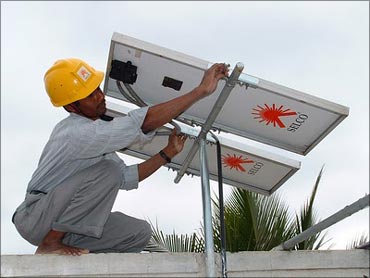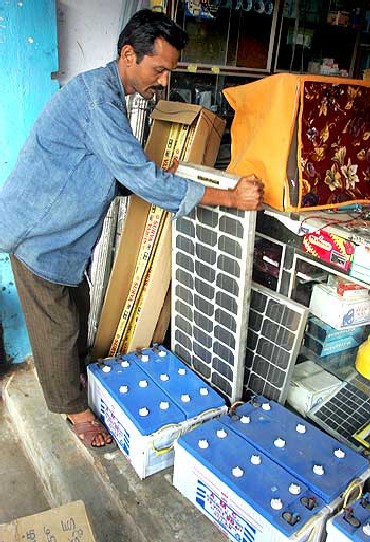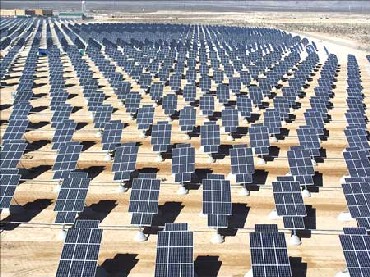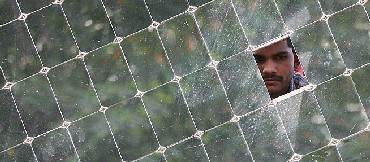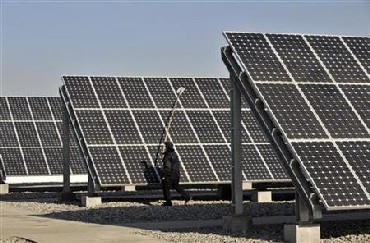 | « Back to article | Print this article |
How this MIT engineer aims to light up rural India
A young entrepreneur with an engineering degree from India's premier engineering school and a postgraduate degree from the US's finest technical school develops an innovative service aimed at ameliorating the energy utility situation in rural India.
In 1995, he co-founds SELCO India, which provides customised energy solutions based on each household's requirements. It facilitates low-income rural households to secure financing help from local financial institutions.
Read how SELCO is taking its solar energy systems to rural homes in the fourth of the five-part series from India Brand Equity Foundation's Innovations from India: Harbingers of Change.
The International Energy Agency (IEA) estimates that about 1.5 billion people or about 22 per cent of the world's population has no access to electricity (as on 2008).
Of the total number of people with no access to electricity, about 85 per cent live in rural areas.
Click NEXT to read more...
How this MIT engineer aims to light up rural India
South Asian countries account for 42 per cent of the total number of people without access to electricity worldwide. About 92 per cent of the people in South Asian countries who live without electricity are based in the rural areas.
In fact, none of the countries of South Asia and the Indian subcontinent have electrification rates above 60 per cent.
It is this situation that presents an impressive market especially for off-grid (electricity not driven by conventional electricity grids) renewable applications.
At present, there are several renewable alternatives for solving the problem of energy utilisation, such as bio gas, geo thermal energy, hydel electricity, hydro electricity and solar energy. Of all these alternatives, solar energy has been touted as the energy utility source with maximum potential.
Click NEXT to read more...
How this MIT engineer aims to light up rural India
However, in spite of so much potential, the use of solar energy has not been pervasive. Factors like the lack of financing options, the lack of strong government policies and incentives, uneven service and after-sales support, and technical weaknesses in batteries meant for India's rugged conditions, have inhibited growth in the use of solar energy.
In addition to equipment cost, the power generated by coal-based sources costs Rs 3.5 to Rs 4 per kilowatt-hour, compared with Rs 17 for power produced by photovoltaic cells.
Harish Hande had a strong belief in the potential of solar energy for solving energy utility issues, and decided to take the challenge head on.
Hande is an electrical engineer from the Indian Institute of Technology at Kharagpur, and has a doctorate in energy engineering from the University of Massachusetts. The idea of venturing into solar energy-based utility solutions came to Hande after visiting the Dominican Republic during his doctoral years at the University of Massachusetts.
Click NEXT to read more...
How this MIT engineer aims to light up rural India
During the visit, he was particularly impressed by the way the citizens of the Dominican Republic were able to improve their lives through solar-based power utilities.
SELCO India was established in 1995 to provide solar energy solutions to underserved households and businesses in India. The company is managed by a board of directors. SELCO was established based on three tenets associated with solar technology:
Poor people can afford sustainable technologies.
Poor people can maintain sustainable technologies.
Social ventures can be run by commercial entities.
Click NEXT to read more...
How this MIT engineer aims to light up rural India
Main features of SELCO's solution
The core business that SELCO focusses on is designing photovoltaic (PV) solar home systems (SHS). The main functionality of these systems is to provide lighting, but they are also suitable for operating radios, cassette players and ceiling fans.
A basic solution consists of four 7-watt compact fluorescent lights (CFLs); a photovoltaic cell, which is mounted on a rooftop; and a lead acid battery for storing the electrical power generated by the PV cell.
This enables the use of energy during both the day and the night.
Click NEXT to read more...
How this MIT engineer aims to light up rural India
Here are the key highlights of SELCO's innovative energy utility solution:
Robust design: The batteries used for storing electrical energy are designed to withstand discharge each day without rapid deterioration.
An electronic charge controller protects the battery from charging or discharging too much. This helps to increase the life of the battery to at least five years.
Customised solution: SELCO aims at empowering its customers by providing a complete package of the product, service and consumer financing. Before any sale, a technician holds an in-depth discussion with the would-be clients about their evening activities, and maps out their homes. Post this activity, the technician proposes a customised lighting plan.
Financial support: SELCO has tried to solve the financing issues that most rural households face. It has rallied hard with local financial institutions (such as grameen banks, cooperative societies, commercial banks and microfinance institutions) to provide financing support to these households.
Click NEXT to read more...
How this MIT engineer aims to light up rural India
Equitable customer care: SELCO has always believed that irrespective of the social and economic status of its customers, the level of service provided to all customers should be the same.
Benefits
The impact of SELCO's initiative has been very encouraging. Some of the benefits seen are:
Ensuring access by increasing affordability: A two-light SELCO home system typically costs $183 (Rs 8,240 )to $237 (Rs 10,670). This is not a small sum for families in rural India, particularly when 60 per cent of SELCO's customers earn $75 (Rs 3,400) to $86 (Rs 3,900) a month.
SELCO works with a variety of local rural banks to help 85 per cent of its customers get financing.
The financing support is facilitated by SELCO through local banks, microfinance institutions, and so on.
Click NEXT to read more...
How this MIT engineer aims to light up rural India
Customised utility service at the customer's doorstep: Along with facilitating doorstep financing, SELCO also offers doorstep servicing. The installation is done by SELCO's technicians, and great emphasis is laid on having the appropriate setup and tidy wiring.
Proactive customer service: After every installation, a technician from SELCO visits customers every three months during the one-year warranty period to ensure that the system is operating properly.
The technician also collects depleted batteries and returns them to the manufacturers for recycling.
Encouraging innovation in energy utility: SELCO has set up an incubation lab. This is the research and incubation arm of SELCO. The lab was set up in April 2009 to develop new clean and sustainable technologies for the rural poor, other than lighting.
An external network of partners (NGOs, technical, financial and academic institutions) helps the researchers at the lab to go beyond insular innovation and bring the technology closer to new customer segments, identifying energy-related problems and devising innovative solutions to them.
Click NEXT to read more...
How this MIT engineer aims to light up rural India
Fostering enterprise capacity: SELCO's initiative has helped customers to augment their productivity. One example of this is that of a woman involved in manufacturing bidis (traditional cigarettes), who was able to increase her production and income by 50 per cent. Her production increased from 400 to 600 bidis a day, while her income increased from $0.6 (Rs 27) to $0.8 (Rs 37) per day.
SELCO is also promoting the cause of new enterprise creation. These enterprises are run by very poor traders who are being engaged in the battery charging business.
These batteries are rented out to other traders at a nominal fee. Such initiatives shall help to increase the pervasiveness of SELCO's energy utility solution.
SELCO currently employs about 170 people in Karnataka and Gujarat. These employees are spread across 25 energy service centres. The company's annual revenue is about $3 million (Rs 13.5 crore). Since 1995, it has sold, serviced and financed over 1,00,000 PV solar systems for its customers.
Click NEXT to read more...
How this MIT engineer aims to light up rural India
SELCO's activities are focussed in rural Karnataka. It is also present in the urban markets of Ahmedabad and Gandhinagar in Gujarat. The company has received the prestigious "Ashden Award for Sustainable Energy".
SELCO currently lights households that earn between $75 and $86 a month. However, by 2012, it hopes to reach families whose monthly earning is less than $64 (Rs 2,900) per month. SELCO's initiative has far more potential than it has been able to showcase.
This conclusion is based on the fact that the government is creating a supportive environment by laying out the National Solar Mission (the mission is a part of a climate change plan unveiled in 2008).
The mission document called for India to increase its solar energy generating capacity to 1,000 megawatts by 2013, and then to 20,000 megawatts by 2022.
Reprinted with permission from IBEF (www.ibef.org). Next week, in the concluding part of the series, read the case study on Novatium, a computing services company.
